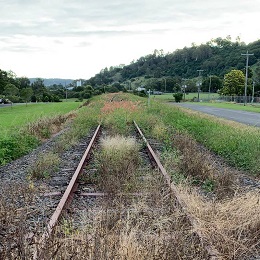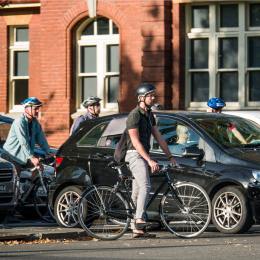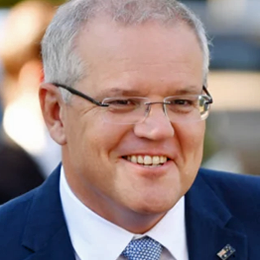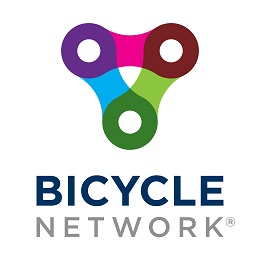Australia heads to the polls on 18 May
Federal Election 2019
Our message to political parties is: build for bikes
Our prioritiesAustralia heads to the polls on 18 May
Our message to political parties is: build for bikes
Our prioritiesAustralia is undergoing rapid and complex changes. Population growth, urbanisation and technological advancements are causing profound changes to our everyday lives and communities.
At the same time, our sedentary lifestyles are killing us. Australians of all ages aren’t getting enough exercise. We’ve reached a crisis point where we have a generation of young people that won’t live as long as their parents.
If political parties truly want to bust congestion, reduce the cost of living, improve health outcomes and protect the future success of our economy, we must make it easier for more Australians to ride bikes, walk and catch public transport. Government policy and infrastructure projects must incentivise physical activity and deter sedentary behaviours.
The long-term benefits of getting more people moving around our cities by bike are well established. Increasing bicycle mode share improves our health, saves money, reduces congestion, improves connectivity and access to employment and positively impacts the sustainability and liveability of our communities.
Despite “supporting measures to increase all aspects of active transport in Australian communities” the government has failed to work with State Governments to deliver desperately needed bike infrastructure or programs.
The Commonwealth Government holds important influence on the provision of economic and social infrastructure that has a major bearing on the whole community’s wellbeing. An integrated, multi-modal transport system is Australia’s greatest preventative health mechanism and congestion-busting tool.
This election, momentum is building for change. Major parties have an opportunity to set a national agenda that shifts our communities towards active transport. More than four million Australians ride bikes every week and many want to, but we need transformative and accountable federal leadership.

Now’s the time to commit to making it easier for more people, of any age or ability, to ride bikes for their own health and happiness and the liveability of the entire country.
Download our Policy paper
The $492 million fund is based on $20 per head for the Australian population. This level of funding broadly matches what is spent in Denmark, London and the Netherlands.
These funds must be available to state governments on an ongoing basis so that bicycle networks are upgraded strategically. The outcome will be a completed network of high-quality bike routes that will greatly reduce use of single occupant vehicles and the demand for roads.
The amount equates to only five per cent of the budgeted nine billion to be spent on communications and transport infrastructure in 2019-20.
Establish a national framework, policy or regulation that requires bike infrastructure to be part of all federally-funded land transport projects.
The provision of new or improved active travel links should be a critical measure of success for all major transport projects, upgrades, works and their ongoing maintenance. It should not be an additional extra. Positive provisioning ensures fair and balanced equity of access for all road users.
Ensure that the criteria of the Building Better Regions Fund makes explicit mention of rail trail proposals that will draw tourism dollars and provide benefits to local and regional communities from a transport, recreation and connectivity perspective.


Incentivise active travel by introducing a scheme where commuters can receive a government benefit of $5 for every trip to work made by bicycle.
If successful, it’s expected the scheme will cost $500 million and encourage even more people to swap short car trips to bicycles, combating congestion and driving down the cost of living.
Invest $3.9 million annually to fund a nation-wide Ride2School program.
Using a proven model of behaviour change within a school community, Bicycle Network’s Ride2School program successfully implements interventions which are proven to increase and promote active travel.
Since 2007, the program in Victoria has achieved significant success in increasing the number of students riding, walking, skating and scooting to school. Schools in the program report an active travel rate of 45 per cent, above the national average of 25 per cent.
Modify the Building Code of Australia to include the provision of end-of-trip facilities
Amend the Building Code of Australia to include the provision of end-of-trip facilities such as bike parking to make riding for transport an easy and accessible option.
Abolish the fringe benefit tax exemption for private vehicles and small business car parking
To motivate more people to swap their cars and prioritise bikes, walking or even public transport, we must remove incentives for single use vehicles and car parking.
Extend fringe benefit tax exemption to bikes or ebikes
To fast-track the uptake and growth of cycling participation as a means of transport, the fringe benefit tax exemption should be extended to private bicycle or ebike use.
The tax scheme for people who ride could mirror what’s done in Belgium and the Netherlands. These European schemes provide tax-free bikes to employees
Actively pursue technologies that improve the safety of heavy vehicles on our roads. Make it a requirement that all heavy vehicles in Australia be fitted with:
To support the widespread implementation of safety upgrades and to subsidise the cost, the federal government should offer rebates to help small owner-operators of heavy vehicle fleets. Strict timelines should be set for implementation so that all heavy vehicle fleets on our roads (both new and old) are fitted with the technology by 2025.
Truck driver training and road user awareness programs are integral to the prevention of crashes involving heavy vehicles.
Funding a national awareness program like Bicycle Network’s Swapping Seats initiative would help to not only raise awareness but build a consistent and clear communication of behaviours for both drivers and bike riders. Vulnerable road user training should also be introduced and mandated across all truck driver licensing curriculums.
Adopt eight key recommendations from Bicycle Network’s submission to the National Transport Commission.
Urgently prioritise and implement the recommendations from the inquiry into the National Road Safety Strategy
It is critical that the following recommendations are implemented to reduce harm and minimise risk for all Australian road users:
A national bicycle crash database would help standardise and centralise data on the nature and causes of crashes. A consistent approach to data collection is essential to ensuring that a true national approach is taken to reducing deaths and serious injury on our roads.
Instruct the Transport Infrastructure Council to apply lower limits on local streets or those streets with high volumes of bike riders
Reduce speeds on local streets or in built up environments to 30km/h.
High speeds discourage men, women and children from riding their bikes for short trips – whether it’s to the local shops, school or work – because they don’t feel safe or comfortable. As fewer people ride and walk, our communities and neighbourhoods become disconnected, disengaged and unhealthy.


Ensure national agendas and strategies consider bikes
To ensure long-term, sustainable and strategic growth of cycling infrastructure, it’s essential that bike riding and active travel organisations have input into related national agenda and strategies including the Australian Government’s Smart Cities Initiative.
Adopt and implement the recommendations from the Australian House of Representatives Standing Committee on Infrastructure, Transport and Cities Building Up & Moving Out report
In examining the Australian Government’s role in the development of cities, the Standing Committee on Infrastructure, Transport and Cities came up with several recommendations regarding connectivity and active transport in their Building Up & Moving Out report.
Recommendation 11:
6.117 The Committee recommends that the Australian Government, as part of the system of master planning under the national plan of settlement, ensure that governments at all levels:
A new national bike riding strategy is needed to ensure the ongoing growth of participation and cycling tourism. It should set ambitious but realistic participation and growth targets and include monitoring and evaluation.
And if you haven’t seen it yet, make sure you check out our Federal Budget submission 2019-20.
Budget submissionAs we receive candidate responses to Bicycle Network’s Federal Election policy paper, we’ll make them publicly available below.
If your local candidates aren’t on this list (excluding Labor who have replied on behalf of all candidates), now’s the time to send them an email or letter asking them to do more for people who ride. Don’t forget to cc’ campaigns@bicyclenetwork.com.au.
Here’s a handy guide that makes contacting your local candidates easy.
Write to candidatesIn the lead up to the election, we’ll update this page with the commitments made by major parties that are relevant or directly impact people who ride. If we’ve missed one, please let us know via email: campaigns@bicyclenetwork.com.au.

The Australian Greens have pledged $1 billion in funding over four years to help make it easier and safer for more people to ride bikes...

Federal Labor has undertaken to fund a new bike path from Greensborough to Montmorency if it forms government after this months election.

Both Labor and The Nationals in have made election commitments to provide funding for a section of the Northern Rivers Rail Trail.

The Shorten campaign announces $4.8M support for a major bike corridor through Footscray, linking West Footscray Station to the Maribyrnong River via Napier Street.

A Shorten Labor Government would invest $500,000 to connecting the dedicated bicycle lane on Cumberland Road in Pascoe Vale with the Upfield Bike Path.

The Australian Labor Party has said they will create a $260 million bike fund to build new cycleways if they win the federal election.

Liberal Treasurer Josh Frydenberg has promised that a re-elected Coalition will invest millions on Melbourne’s Yarra Boulevard and Walmer Street bridge.

Contacting your local candidates this federal election will help strengthen the voice for people who ride bikes in Australia.

Australians should be paid $5 every time they ride a bike to work under a new scheme proposed by Australia’s biggest bike riding organisation, Bicycle...

The Morrison Government has promised to establish an Office of Road Safety if re-elected, a small but important step toward protecting the safety of all...

The answer to traffic congestion in our capital cities isn’t in cutting back permanent migration, it’s in investing and creating space for active transport.

News that another bike rider has been horrifically killed in a crash with a truck highlights the urgent need to address the risk that heavy...
Contact your local candidates and ask what they’re doing for bikes. We’ll share their responses online – just make sure you cc us at campaigns@bicyclenetwork.com.au
Need help? Check out our handy guide.
Write to candidatesShare our election campaign on social.
Become a member today and together we can make it easier for more people to ride.
Join nowBecome our friend
Find out more about Bicycle Network and support us in making it easier for people to ride bikes.
Authorised by A Hargreaves Level 4, 246 Bourke Street, Melbourne VIC 3000